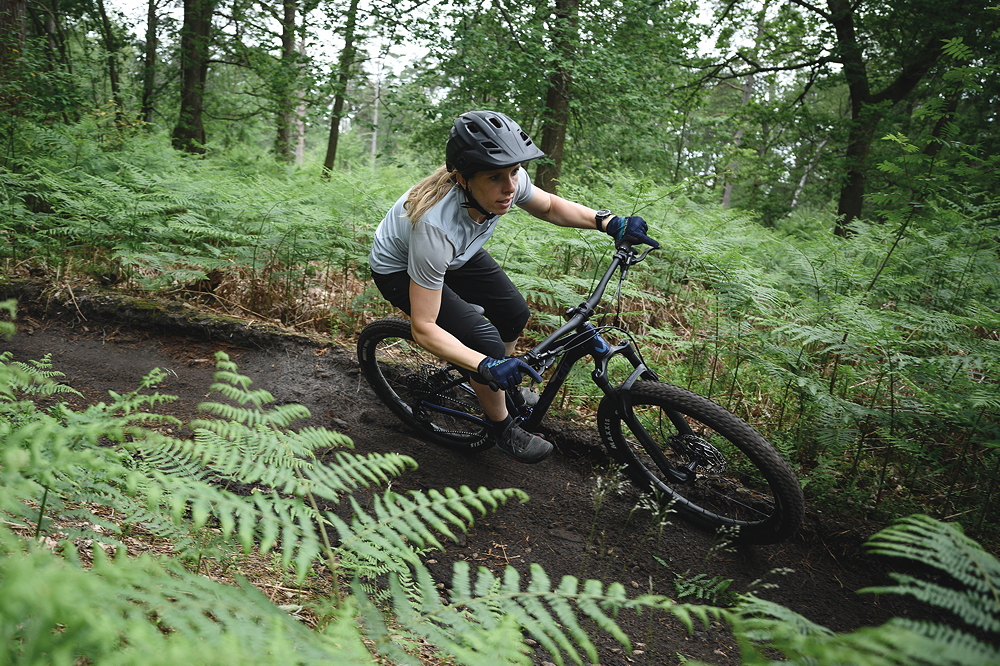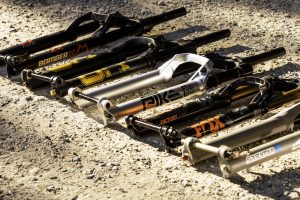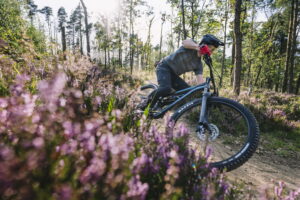We bring you the rundown of the very best mountain bikes under £3,000/$4,000. Trail bikes with 27.5in, 29in and MX-style mixed wheel sizes.
The absolute best mountain bikes for under £3,000/$4,000 are serious bits of kit. It’s at this level that you start to see carbon frames enter the fray, and sophisticated suspension with adjustable compression damping. There will be wheel size options, including 29in and 27.5in front and rear as well as mixed wheel ‘mullet’ bikes.
Choose from direct-sales models for the best value, or shop sold brands for the personal service and expertise of a good bike shop. At this price point we’d recommend most riders should look at full-suspension options, but if you don’t need rear suspension then look at our buyer’s guide to the best hardtail mountain bikes.

Specialized’s classic four-bar suspension delivers on its promise of 160mm travel
1. Specialized Status
Affordable mixed wheel fun factory
Wheel size: 29in f/27.5in r | Frame sizes: S1, S2, S3, S4, S5 | Weight: 15.75kg | Suspension travel: 160mm f/160mm r | Rating: 10/10
Reasons to buy:
- Killer value for money
- Inspiring handling
Reasons to avoid:
- Sluggish NX shifting
If you’re starting to see a few grey hairs appear then you may well remember the iconic Specialized Big Hit. Although not the original mullet bike, it was perhaps the most successful mixed wheeler before the trend’s recent resurgence. Why was it such a big hit, if you’ll excuse the pun? Well, it wasn’t designed for long distances or going racing, it was built to put a smile on riders’ faces. And it succeeded in spades. The Status invokes the spirit of that classic Big Hit, with a mixed wheel set-up, an affordable price and the ability to generate fun at every turn. There are two models on offer, one with 140mm travel and the original version with 160mm travel. Whichever one you pick, you’re in for a great time.
Read our full review of the Specialized Status 160

The Cannondale Habit 4 puts a smile on your face, as well as your bank manager’s
2. Cannondale Habit
Best for bike parks and playing about on jumps
Wheel size: 27.5in (XS) and 29in | Frame sizes: XS (27.5in), S, M, L, XL | Weight: 15.2kg | Suspension travel: 140mm f/130mm r | Rating: 9/10
Reasons to buy:
- Agile and easy to ride, the Habit handles like a much more expensive machine
- Shock tune feels perfect
- Fun and flicky ride that keeps rider weight well-balanced on all trail gradients
- SRAM DB8 brakes feel solid and have a smooth action for a budget brake
Reasons to avoid:
- Maxxis Rekon tyres use harder compound with less wet weather grip
The new Cannondale Habit offers both carbon and aluminium frames, a broad range of sizes, and even a longer travel option if you’re heading into bigger terrain. But perhaps its key selling point is a focus on creating the same ride and handling across the whole size range, so you should experience the same ride quality whatever your height.
Cannondale has also nailed the rear suspension performance, helping to boost confidence however chunky the terrain. Ultimately we loved how it rode, with really active suspension and dynamic handling. To sum up, we said: “As a pure trail bike, it nails the fundamentals of geometry, suspension and efficiency and has an engaging, responsive ride quality that feels anything but budget”.
Read the full review of the Cannondale Habit 4

The Marin Rift Zone XR impressed us with its ride quality.
3. Marin Rift Zone
Best no-frills trail bike for upgrading
Wheel size: 27.5in or 29in | Frame sizes: S, M, L, XL | Weight: 15.54kg | Suspension travel: 150mm f/140mm r 27.5in, 140mm f/135mm r 29in | Rating: N/A
Reasons to buy:
- Exploitable handling, whatever your level
- A bike that can grow with your skills
- Fun to ride
- No gimmicks
Reasons to avoid:
- You’ll find better spec from a direct-sales brand
- No dropper post on the cheaper models
Marin’s new Rift Zone captures the essence of agile handling and an engaging ride and slaps on a price tag that doesn’t just appeal to hedge fund managers. Consumers get to choose between three wheel sizes; 27.5in and 29in obviously, but there’s also a 26in JR model for the groms. Build kits start at £1,695 and go up to £2,995 for the XR model.
In a world of sagging scales, bottomless travel and stratospheric price tags, the Rift Zone is as refreshing as plunging your face into a glacier-fed stream. It reminds you that it’s fun, rather than frills, that’s important in a mountain bike. if you prefer to let your riding do the talking rather than strut about preening your feathers on something that cost the equivalent of a house deposit, then the Rift Zone won’t disappoint.
Read our full review of the Marin Rift Zone XR (2023)

Integrated suspension system conceals the RockShox NUDE 5 shock inside the full carbon frame
4. Scott Spark
Best for speed freaks and XC racers
Wheel size: 29in | Frame sizes: S, M, L, XL | Weight: 11.12kg | Suspension travel: 120mm f/120mm r | Rating: 9/10
Reasons to buy:
- Ruthless in its efficiency
- Hidden shock should need less maintenance
Reasons to avoid:
- Suspension could be more supple in Descend mode
Scott’s Spark has won more trophies than any other race bike, with double Olympic gold back in 2016. Redesigned recently with a sleek new frame and more modern geometry, the Scott Spark has lost none of its potency, but it has become even more versatile. It also gets a hidden shock for reduced maintenance, and remote suspension control for uphill efficiency without compromising on downhill confidence.
Read our full review of the Scott Spark RC WC AXS

Trek’s Top Fuel 8 offers a high-octane ride
5. Trek Top Fuel
Best for playful suspension
Wheel size: 29in | Frame sizes: S, M, M/L, L, XL, XXL | Weight: 14.89kg | Suspension travel: 130mm f/120mm r | Rating: 9
Reasons to buy:
- Poppy, playful and efficient
- Available in six frame sizes
- Internal down tube storage
- Mino Link flip chip allows geometry tweaks
Reasons to avoid:
- Accurate rear shock set up is crucial
- A solid build means it’s not the lightest in its class
Don’t buy the Trek Top Fuel if you’re after the lightest down-country bike on the market. At 14.89kg (32.83lb), it isn’t that much lighter than a 150mm bike. But, if you want a short travel bike that’s amazingly playful and fun to ride, then you’ve come to the right place. The sizing is generous, and there are loads of frame sizes to choose from, so you’ll definitely be able to get comfortable. And the internal storage, even on the alloy frames, is a real boon for anyone who likes to take the weight off their backs.
Read our full test review of the Trek Top Fuel 8

Whyte’s 909 X Enduro hardtail lets its fat tyres take the sting out of the trail.
6. Whyte 909 X
Best hardtail for comfort
Wheel size: 27.5in | Frame sizes: S, M, L, XL | Weight: 13.61kg | Suspension travel: 130mm front | Rating: 9/10
Reasons to buy:
- Superb ride quality
- Dialled geometry
- Neat details
Reasons to avoid:
- It’s expensive for a hardtail
Who said Plus size tyres were dead? Clearly Whyte doesn’t think so and after testing the 909 X we wholeheartedly agree that they still have a seat at the wheel size table. Combine the high quality frame with the high volume 2.8in Plus size Maxxis tyres, and the Whyte 909 X offers unparalleled levels of comfort, grip and control. Now, we’re not talking full suspension levels here, as it’s only the difference between a 2.4in tyre and a 2.8in, but it is a noticeable improvement and it’s really appreciable in rougher trails.
And taken with the dialled geometry and finely tuned flex in Whyte’s alloy frame, the 909 X is the closest thing here to riding a soft-tail.
Read our full review of the Whyte 909X

Should I buy a full-suspension bike or a hardtail for under £3,000?
Weight conscious cross-country riders are arguably still better served with a hardtail, but everyone else is probably better off on full-suspension as it brings much more comfort and control, especially on rough terrain. Modern full-suspension bikes pedal very efficiently now, so you won’t waste much energy through the suspension ‘bobbing’ either.
Should I get a carbon or alloy frame for under £3,000?
Carbon enters the arena here, mainly with direct-sales brands, but choice is still limited and we wouldn’t say that carbon is a deal breaker. In fact we’d usually recommend sticking with an alloy frame, as the weight disadvantage is often only around 500g, but it will mean you can enjoy much better components, such as better damping in the fork and shock, and lighter wheels, which can make more of a difference to the way the bike rides than a lighter frame. Either way, most platforms use the same frame on all models, so the top bike will have an identical frame as the cheapest model. The advantage with this system from a consumer’s perspective, is that you know the heart of the bike is the same quality, whatever the price, and that any upgrades will be worthwhile investments.
What components should I look out for under £3,000?
Make sure the bike has a dropper seatpost, as this will really help your descending. The suspension fork and rear shock should have compression damping adjustment as well as rebound adjustment. Look for easily serviceable parts, such as threaded bottom brackets and bearing kits for all the suspension pivots. In terms of drivetrain, SRAM GX or Shimano XT (or better) are preferable, but SLX and NX Eagle may well be used in places. Try to avoid SRAM’s NX Eagle cassette (designated PG-1230) as it is very heavy and uses a different freehub body that isn’t compatible with the lighter cassettes used further up the range.















